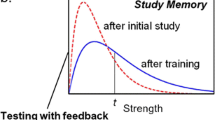Abstract
As a “base line” of memorization performance, the behavior of a “perfect learner” is considered. He is characterized by a perfect memory and by the ability to choose the best search procedure in problems where the correct response from a given repertoire is to be found to each of several stimuli under the condition of “right” and “wroing” promptings by the experimenter.
Expected learning curves are derived for the case of disjoint response repertoires associated with the stimuli under cyclic and random presentation of the stimuli and for the case of a single response repertoire (a one-to-one matching problem) under cyclic presentation.
Similar content being viewed by others
Literature
Harlow, H. 1959. “Learning Set and Error Factor Theory,” inPsychology: A Study of a Science, (S. Koch, ed.), Vol. II. New York: McGraw-Hill.
Landahl, H. D. 1941. “Studies in the Mathematical Biophysics of Discrimination and Conditioning II: Special Case: Errors, Trials, and Number of Possible Responses.”Bull. Math. Biophysics,3, 71–77.
Livant, William (Unpublished Thesis). “A Study of the Rate of Gain of Information in Rote Learning and Concept Formation.”
Rapoport, A. 1960. “A Derivation of a Rote Learning Curve from the Total Uncertainty of a Task.”Bull. Math. Biophysics,22, 85–97.
Author information
Authors and Affiliations
Rights and permissions
About this article
Cite this article
Rapoport, A. The perfect learner. Bulletin of Mathematical Biophysics 23, 321–335 (1961). https://doi.org/10.1007/BF02476490
Received:
Issue Date:
DOI: https://doi.org/10.1007/BF02476490




